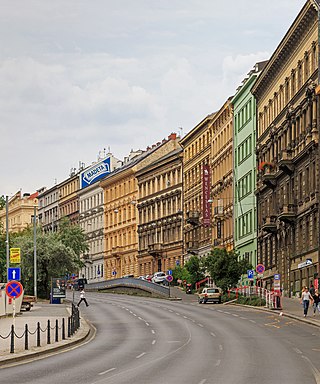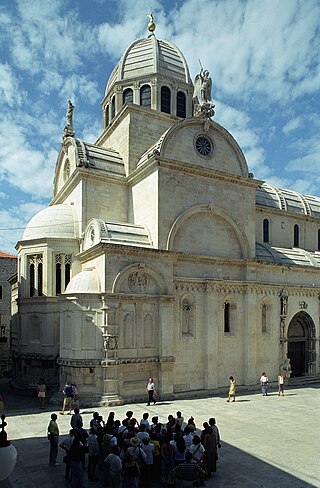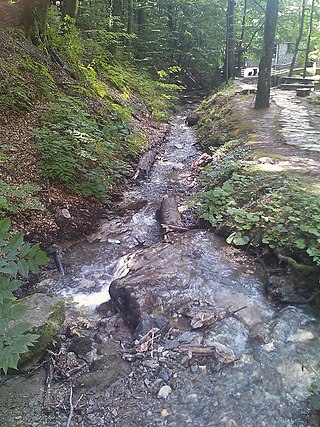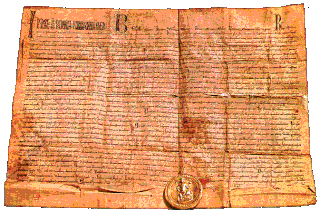
Ston is a settlement and a municipality in the Dubrovnik-Neretva County of Croatia, located at the south of isthmus of the Pelješac peninsula.

Tourism in Croatia is a major industry of country's economy, accounting for almost 20% of Croatia's gross domestic product (GDP) as of 2021.

Hvar is a town and port on the island of the same name, part of Split-Dalmatia County, Croatia. The municipality has a population of 4,251 (2011) while the town itself is inhabited by 3,771 people, making it the largest settlement on the island of Hvar. It is situated on a bay in the south coast of the island, opposite from the other nearby towns of Stari Grad and Jelsa.

New Town is a quarter in the city of Prague in the Czech Republic. New Town is the youngest and largest of the five independent towns that today comprise the historic center of modern Prague. New Town was founded in 1348 by Charles IV just outside the city walls to the east and south of the Old Town and encompassed an area of 7.5 km2; about three times the size of the Old Town. The population of Prague in 1378 was well over 40,000, perhaps as much as twice that, making it the 4th most populated city north of the Alps and, by area, the 3rd largest city in Europe. Although New Town can trace its current layout to its construction in the 14th century, only few churches and administrative buildings from this time survive. There are many secular and educational buildings in New Town, but also especially magnificent gothic and baroque churches. These nevertheless are not the main drawing points for tourists. New Town's most famous landmark is Wenceslas Square, which was originally built as a horsemarket and now functions as a center of commerce and tourism. In the 15th century, the Novoměstská radnice, or New Town Hall, was the site of the first of the three defenestrations of Prague.

Gornji Grad–Medveščak is one of the districts of Zagreb, Croatia; Gornji Grad translates as "Upper Town", referring to its historical location on city's hillside, being above Donji Grad. The district is located in the central part of the city and, according to the 2011 census, it has 30,962 inhabitants spread over 10.19 km2 (3.93 sq mi).

The Zagreb Cathedral, is a Catholic cathedral in Kaptol, Zagreb. It is the second tallest building in Croatia and the most monumental sacral building of Gothic architecture southeast of the Alps.
The Nova Ves is a historic street north of the Kaptol neighborhood in Zagreb, Croatia. It is administratively within the bounds of the Gornji Grad - Medveščak city district. According to the 2001 census, the street and its surrounding area had 3,456 inhabitants. In 2009, it had a population of 3,575. From the first habitation to date, the street has had a rich history as an important part of Zagreb ever since the beginnings of the modern city.

Jelsa is a town in Croatia, on the island of Hvar, the seat of the eponymous municipality (općina) within the county of Split-Dalmatia.

Gradec, Grič or Gornji Grad is a part of Zagreb, Croatia, and together with Kaptol it is the medieval nucleus of the city. It is situated on the hill of Grič. Today this neighbourhood forms part of the Gornji Grad-Medveščak district.
The history of Zagreb, the capital and largest city of Croatia, dates back to the Middle Ages. The Romans had built a settlement, Andautonia, in present-day Ščitarjevo. The name "Zagreb" was first used in 1094 at the founding of the Zagreb diocese in Kaptol, after the Slavs had arrived in the area. Zagreb became a free royal city in 1242. It was made the capital of Croatia in 1845 and elected its first mayor, Janko Kamauf, in 1851. According to the 2011 Croatian census, Zagreb had 792,875 inhabitants and was also Croatia's largest city by area.

Pregrada is a town and municipality in Krapina-Zagorje County in Croatia. In the 2011 census, there were 6,594 inhabitants in the following settlements:

The architecture of Croatia has roots in a long history: the Croats have inhabited the area for fourteen centuries, but there are important remnants of earlier periods still preserved in the country. The historic architecture of most old towns on the coast is Venetian, a legacy of the Venetian empire. The Habsburg and Ottoman empires also influenced the architecture of the region.

Korčula is a town on the east coast of the island of Korčula, in Croatia, in the Adriatic.

Medveščak is a creek in central Zagreb, Croatia. It flows from Kraljičin zdenac in Podsljeme down along the southern slopes of the Medvednica mountain to the Manduševac Fountain, its mouth. The creek was covered in 1898 and today forms part of the Zagreb sewer system. Medveščak has long served as an important geographical feature of historic Zagreb, delineating the border between the often warring twin cities of Gradec and Kaptol between the 11th and the 19th century and causing many violent floods which often decimated houses on its banks. Most of the stream is located in the Gornji Grad - Medveščak city district, running underground under Tkalčićeva and Medvedgradska Streets.

Tkalčićeva Street is a street in the Zagreb, Croatia city center. Extending from the vicinity of the central Ban Jelačić Square to its northern end at the Little Street, the street flows between the Gornji Grad in the west and Nova Ves in the east. The street is administratively within the Gornji Grad–Medveščak city district, constituting the former "August Cesarec" commune.

The Golden Bull of 1242 was a golden bull or edict, issued by King Béla IV of Hungary to the inhabitants of Gradec during the Mongol invasion of Europe. By this golden bull, King Béla IV proclaimed Gradec a royal free city. The document was issued on 16 November 1242 in Virovitica and reaffirmed in 1266. The original is written on a piece of parchment 57 by 46 centimetres in size, and is kept in strictly controlled conditions in the Croatian State Archives in Zagreb, while a copy is exhibited in the Zagreb City Museum.

The Church of St. Mark is the parish church of old Zagreb, Croatia, located in St. Mark's Square. It is one of the oldest architectural monuments in Zagreb.
The following is a timeline of the history of the city of Zagreb, Croatia.

Paz is a village and ruined castle in Istria County, Croatia, in the municipality of Cerovlje. In 2011, the population of the village is 72.

The Kaptol manors form a series of 25 manors along the Kaptol Street in Zagreb, Croatia that were used to house canons and other officials of the Archdiocese of Zagreb. The manors were built at various times between the Middle Ages and the 19th century. Most of those preserved date from the Baroque period, while those in the best condition are mostly from the 19th century. The manors were designed as large town houses surrounded by gardens. Each has its own history and peculiarities. The most important are those which were inhabited by prominent canons.

























